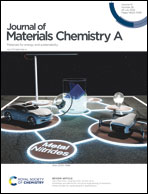A lateral built-in field of the 2D/2D SnS2/SnSe2 in-plane heterostructure with boosted interfacial charge transfer†
Abstract
Heterostructure construction is an effective strategy for enhancing the properties of functional materials. However, the problems of lattice mismatch and weak built-in field in the heterointerface usually degrade the interfacial charge transfer efficiency, severely limiting the improvement of sensing properties for gas sensors. To break through this limitation, we attempted to build a lattice-matched SnS2/SnSe2 in-plane heterostructure as a NO2 gas sensor, for which the capability was revealed by DFT calculations. The SnS2/SnSe2 in-plane heterostructures with atomically sharp interfaces were synthesized by the topotactic anion-exchange method. The content and spatial arrangement of in situ grown SnSe2 can be tuned in the heterostructures by adjusting the Se precursor. Ultrahigh response (1165.2%), sensitivity (322.0% ppm−1) and rapid response/recovery (80/78 s) to NO2 (4 ppm) were realized at room temperature for the optimal SnS2/SnSe2 in-plane heterostructure. The response value was 24.7 and 9.5 times higher than that of the common SnS2/SnSe2 heterostructures prepared by mechanical mixing and solvothermal deposition, respectively. The response and recovery times were also improved by a factor of 3.5/8.9 and 1.6/4.9, respectively. The superior sensing properties are attributed to the atomic-level sharp in-plane SnS2/SnSe2 heterointerface with a lateral built-in field that not only improves NO2 adsorption but also boosts the interfacial charge transfer along the 2D plane. The ion-exchange growth of the 2D in-plane heterostructure is expected to expand to other 2D nanomaterial systems for applications in sensors, photoelectronics, and catalysts.



 Please wait while we load your content...
Please wait while we load your content...